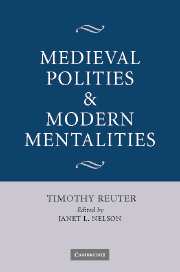Book contents
- Frontmatter
- Contents
- Editor's note
- Acknowledgements
- List of abbreviations
- Editor's introduction
- PART I MODERN MENTALITIES: HISTORIOGRAPHIES, METHODOLOGIES, PRECONCEPTIONS
- PART II THE SYMBOLIC LANGUAGE OF MEDIEVAL POLITICAL ACTION
- PART III POLITICAL STRUCTURES AND INTENTIONS
- 11 Assembly politics in western Europe from the eighth century to the twelfth
- 12 Sex, lies and oath-helpers: the trial of Queen Uota
- 13 Plunder and tribute in the Carolingian empire
- 14 The end of Carolingian military expansion
- 15 The Ottonians and Carolingian tradition
- 16 The making of England and Germany, 850–1050: points of comparison and difference
- 17 King, nobles, others: ‘base’ and ‘superstructure’ in the Ottonian period
- 18 The ‘imperial church system’ of the Ottonian and Salian rulers: a reconsideration
- 19 Peace-breaking, feud, rebellion, resistance: violence and peace in the politics of the Salian era
- 20 The medieval German Sonderweg? The empire and its rulers in the high Middle Ages
- 21 Mandate, privilege, court judgement: techniques of rulership in the age of Frederick Barbarossa
- 22 All quiet except on the Western Front? The emergence of pre-modern forms of statehood in the central Middle Ages
- Index
18 - The ‘imperial church system’ of the Ottonian and Salian rulers: a reconsideration
Published online by Cambridge University Press: 12 August 2009
- Frontmatter
- Contents
- Editor's note
- Acknowledgements
- List of abbreviations
- Editor's introduction
- PART I MODERN MENTALITIES: HISTORIOGRAPHIES, METHODOLOGIES, PRECONCEPTIONS
- PART II THE SYMBOLIC LANGUAGE OF MEDIEVAL POLITICAL ACTION
- PART III POLITICAL STRUCTURES AND INTENTIONS
- 11 Assembly politics in western Europe from the eighth century to the twelfth
- 12 Sex, lies and oath-helpers: the trial of Queen Uota
- 13 Plunder and tribute in the Carolingian empire
- 14 The end of Carolingian military expansion
- 15 The Ottonians and Carolingian tradition
- 16 The making of England and Germany, 850–1050: points of comparison and difference
- 17 King, nobles, others: ‘base’ and ‘superstructure’ in the Ottonian period
- 18 The ‘imperial church system’ of the Ottonian and Salian rulers: a reconsideration
- 19 Peace-breaking, feud, rebellion, resistance: violence and peace in the politics of the Salian era
- 20 The medieval German Sonderweg? The empire and its rulers in the high Middle Ages
- 21 Mandate, privilege, court judgement: techniques of rulership in the age of Frederick Barbarossa
- 22 All quiet except on the Western Front? The emergence of pre-modern forms of statehood in the central Middle Ages
- Index
Summary
There is a general consensus among historians that there was something quite special about the church policy of the Ottonian and Salian rulers of Germany from Henry I to Henry III. The normal reliance of the medieval king on his prelates was here turned into a deliberate and systematic exploitation of the potential of the Church as an instrument of government. These rulers used bishops and abbots, whom they appointed, as a counterweight to a turbulent and unreliable lay nobility. Many historians have, so to speak, followed them in this, have turned from the Ottonians' and Salians' complex and seemingly unsatisfactory relations with their aristocracy to their church policy. Here they have seen plan, system and harmony, so much so that the Church has come to be regarded as the principal instrument of government available to these rulers. Our picture of the Ottonian and Salian ‘imperial church system’, the Reichskirchensystem of German historians, has been much refined by recent scholarship, but the essential outlines have not greatly altered since the time of Waitz and Giesebrecht. The purpose of what follows is to re-examine these outlines. The qualifications, doubts and reinterpretations offered are not all new; many have been expressed or at least hinted at in the existing literature. But they have never been fully articulated, and it seems worth looking again at the Reichskirchensystem as a whole to ask how far in fact it did perform or could have performed the functions usually attributed to it, and to ask also how far it was a system.
- Type
- Chapter
- Information
- Medieval Polities and Modern Mentalities , pp. 325 - 354Publisher: Cambridge University PressPrint publication year: 2006
- 2
- Cited by



